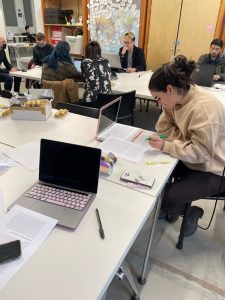In this post, Hannah Morley and Linh Dao, two of our student researchers from the School of Design at Sheffield Hallam University, share the results of a series of workshops that they ran with their peers this academic year.
Goals
Our involvement in the Active Online Reading project prompted us to try to understand the current reading practices of a group of design students using electronic devices. We also hoped to be able to suggest how the experience of reading online might be improved.
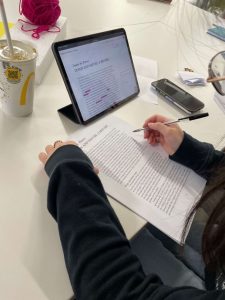 The goals of the research project were:
The goals of the research project were:
- To discover design students’ current practice of online reading and how they feel about the overall experience;
- To learn about students’ current pain points, frustrations, and barriers to reading online;
- To uncover the current tools/apps that Design student are using to read online books and journal articles, and their experience with those tools;
- To understand what reading means to Design students (how they define it) and why it is important to them.
For this project, we focused on both UK and international students and the challenges that they face in the academic setting.
Workshops
We conducted three workshops (a Traditional Text workshop, a Digital workshop and a Making through Materiality workshop) to gather background information about the research demographic. We invited 5 people, but in the end, we got more, with 7 volunteers in total.
Our demographic was internationally diverse, master’s level, and came from various Design disciplines. Our next step was to conduct informational interviews with these Design students to understand the target demographic better.
We first prepared a jar and asked people to anonymously note down their feelings towards reading in general before and after the workshop, by putting the note into the jar.
Before the workshop, they had negative feelings about reading and preferred visual activities. This is to be expected as these were Design students. However, after the workshop, reading along with visual and creative tasks created much more excitement, and they seem to have found it stimulating.
Informational interviews
The goal was to have a conversation about their unique experiences as Design students reading academic documents.
- Based on your experience, do you prefer reading on paper or electronic devices?
- In which language(s) do you usually take notes?
- Can you explain why you annotated that paragraph in that particular way?
- How do you feel about reading academic journals/books?
Their responses to these questions were insightful and made us reconsider some of the assumptions we had taken into the interviews.
Key Quotes
- “Typically, I find a quote I like in a text; then I use the search bar on keywords and topics from the quote to read around the topic and find other texts that might be related to my design research.”
- “I prefer traditional reading as it’s interesting to physicalise what I have read. That is why I enjoyed the Making through Materiality task and our previous module.”
- “Reading overall was terrible on the platform as I had to translate a lot.”
- “Reading digitally has many benefits, but I don’t enjoy them as much from my perspective. It is convenient and easy to access because you can read anywhere, and it does not take up space. You can have free readings, in many cases at no cost.”
Research Synthesis
With so many different insights, we decided that coding and tagging the qualitative data would be the most effective means of analysing and synthesising the information.
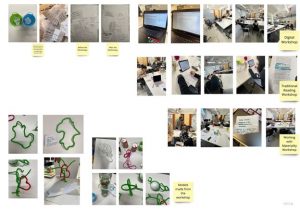
Some key insights included:
- Most participants’ reactions to reading, in general, were quite negative. Participants explained that they typically learn and engage more from visual materials and methods than text.
- Most participants’ typical reading routine is to research as much as possible to begin a project before moving on to more creative research methods. This could explain why students have much more of a negative attitude towards reading as they prefer the creative elements to the academic parts of the course.
- Most participants’ reactions to reading remained the same over the course of the workshops. However, about half of them seemed to enjoy the Making through Materiality workshop, finding it interactive and engaging compared to the other methods that were used.
Traditional Text workshop
- We asked the participants to read and annotate a paper document.
- Some enjoyed this activity because they could hold the text physically and actively annotate it how they wished. However, some find traditional texts harder to engage with as it is more challenging to keep pages together and you cannot write on all kinds of physical resources (e.g. library books).
- Two students from the study surprisingly engaged with the text by annotating in their native languages [Chinese and Vietnamese]. One student explained that they annotated in their native language on the traditional text but not the digital workshop because it is easy to look up unfamiliar words on a digital device and annotate in English, whereas it is easier to translate key parts and then annotate it in their own language.
Digital workshop
- We asked the participants to read a document on the Talis Elevate tool.
- Most participants told us typically they start with digital reading first as a quick way of gathering information to begin a project (e.g. to generate a research question and title).
- Interestingly, each student read differently.
- Two students used the platform to highlight quotes, another added annotations/ comments instead. One student created notes in a Word document. Another spent the time just reading the text, and the final student handwrote her notes from the digital document as that is the way she prefers to analyse text actively.
- This shows that even though the students are all designers, each has their own research practice regardless of specific discipline or nationality.
Making through Materiality workshop
- We asked the participants to create artefacts from of a document.
- T
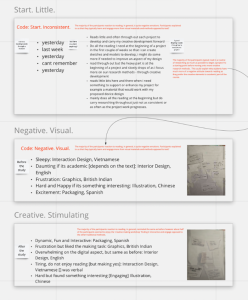 he majority of the participants enjoyed this workshop and confirmed that they would continue to use this approach in their future research practices.
he majority of the participants enjoyed this workshop and confirmed that they would continue to use this approach in their future research practices. - Interestingly, no participant used pen and paper in this activity even though we had laid out all kinds of mixed media so that the individual could decide what they wished to use as well as what quote or keyword they would use as a starting point to interrupt. The majority of participants chose to pipe cleaners as a medium and only used an individual word to interrupt instead of a sentence.
Problem Statement
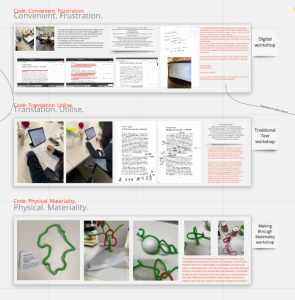
After analysing and synthesising the data, we came up with statements that could properly summarise the findings:
- Overall, participants preferred either a blend of digital and traditional reading or just traditional reading. Not one student expressed a preference for digital reading. This may be related to creative an visual nature of the discipline.
- Many participants enjoyed the Making through Materiality Workshop and found it beneficial to be able to visualize the texts that they were analysing in a 3D form.
- The typical Design student’s online reading workflow can be summarized as follows:
- Skim the paper → Highlight key words → Google these words to discover more → Collect notes/highlights → Take notes elsewhere (on paper or an app to organise thoughts).
Links:
Miro board illustrating the process of analysis: https://miro.com/app/board/uXjVOPqAEbA=/?invite_link_id=158399689933
